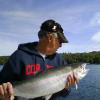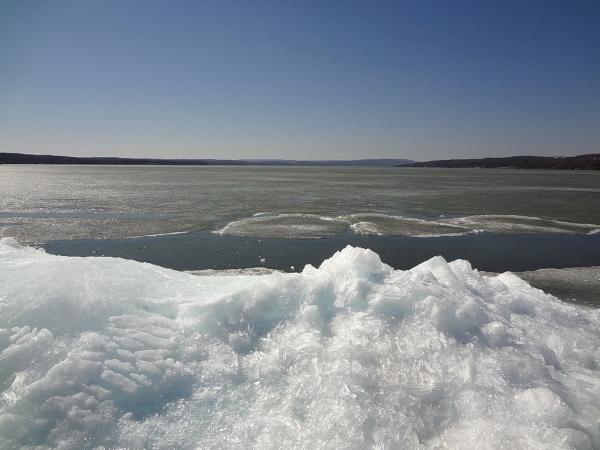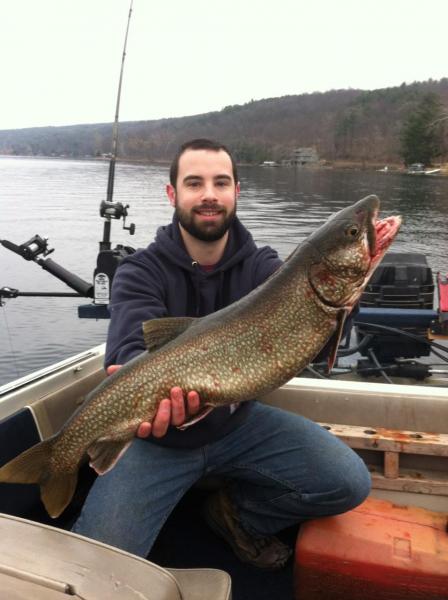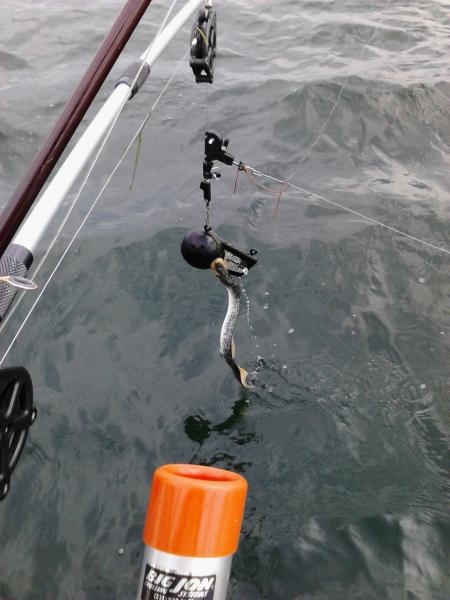-
Posts
261 -
Joined
-
Last visited
Content Type
Profiles
Forums
Events
Gallery
Store
Everything posted by Bigfoot
-

How much ice is still on Canandaigua?
Bigfoot replied to Iron Duke's topic in Finger Lakes Discussion
The south end of Canandaigua is ice free. There is ice from just north of Vine Valley until almost the shallows on the north end. The lake is high and only about one foot lower than the parking lot at Woodville Launch. DEC hasn't put the docks in yet, so launching would difficult (depending on the wind and the size of your rig). At least with the high water one's prop should be safe...... -

Keuka 3/31/14 (My biggest Laker to date)
Bigfoot replied to Guppy35's topic in Finger Lakes Discussion
For what it's worth, I saw a 14 pound laker win an Avon Anglers derby and one year the winner of the North End Landings derby was a 19 pound laker. This lake can definitely produce big fish, but we need to continue thinning out the overpopulation of 2-3 pound lakers. Catch and release is detrimental to this lake!!!! -
Are you talking about the "Chamber of Commerce" launch or the one in the state park?
-

How much ice is still on Canandaigua?
Bigfoot replied to Iron Duke's topic in Finger Lakes Discussion
-

How much ice is still on Canandaigua?
Bigfoot replied to Iron Duke's topic in Finger Lakes Discussion
-
DEC stream surveys indicate that the Catherine Creek system produces an enormous number of young (less than one year old) rainbows. The same surveys also show that the number of age class two fish is pitifully small. One of the reasons for this is that the stream lacks overhead cover-which leads to greater predation from lifters, herons and also results in undesirable higher summer time water temps. Until the habitat is restored, don't expect populations to rebound. My own experience with catch and release rainbow fishing was a disaster. When I was a college student during the late 70's in Rochester I used to pound a small Lake Ontario trib. I had the place to myself and I could and did fish every day during the spring run. One day I really got into them and had one of those days to die for. Returning the next day I discovered many of the rainbows that I had caught and carefully released the day before dead. I had unwitting killed them with my catch and release. They could not withstand the stress, coming at a time when they are already stressed from their reproductive activities. I do not fault those who elect to release their catch, in fact I encourage it. But let's not forget that some of those fish won't survive.
-
Back in the day they had a sign there that told how many fish ran in the fall and how many ran in the spring. Many of the small males run in the late fall/early winter and spend the winter in deep holes- so even if the spring run has started, there should be fish in the creek, but not necessarily in the headwaters yet. The warmer weather (at last) forecast for later this week should trigger some fish movement.
-
I'm not sure what you mean by operational. For most of the year the fishway is open allowing unobstructed passage upstream and no staffing is needed. Sometimes in winter this is not the case, as the passage way becomes blocked with anchor ice. In spring, after the anchor ice melts, the fish on their spawning runs are diverted into a large pen in the fishway, and can not proceed upstream until released by DEC staff. Staff collect data on the fish (length , weight, fun loving) and I believe they still tag them. Additionally, some rainbows are retained so that their eggs and milt are available for hatchery use. During the spring runs, staff are only present a few hours a day, so it can be difficult to catch up with them. While most fish are allowed to continue upstream, lampreys are removed and destroyed. After the lamprey run is over, the barrier is removed and the fishway again provides unobstructed passage.
-
Reports in the local papers said that DEC shocked over 200 rainbows in Catherine Creek, including 2 over 12 pounds. Fish have not spawned yet, it looks like a good year for the "fishermen" and a horrible year for the fishery. I haven't heard how the shocking went on the other tribs.
-
Yes, the tournament is on April 5th. Avon Anglers website does not seem to have been updated since last Fall. However, details of the perch derby are on their Facebook page.
-
I believe that each age class from a hatchery are clipped the same and then distributed to the various lakes. Sometimes lakes could be stocked with fish from multiple sources due to shortages (due to disease at one hatchery for instance),so different clips could occur between the lakes. It looks to me that the differences between the Canandaigua and Seneca clips are just a reflection of the fact that Lake Trout can live 20 years or so and that Seneca has been stocked that long and Canandaigua has not.
-
Canandaigua Lake trout have the following fin clips: Fin Clip AGE Right Ventral 3,8 Right Pectoral 5,11 Left Ventral 2,7 Left Pectoral 1,6 Adipose 4,10 Adipose and Right Pectoral 2 Adipose and Left Pectoral 3 Adipose and Left Ventral 6,12 Adipose and Right Ventral 1 Left Ventral and Right Pectoral 4 Dorsal 9,15 Dorsal and Adipose 5
-
According to DEC Lake Trout in Seneca Lake have the following fin clips: Clip Age Right Ventral 3,8,14 Right Pectoral 5,11,17 Left Ventral 2,7,13 Left Pectoral 6,12,18 Adipose 4,10,16 Adipose and Right Pectoral 2,8,14 Adipose and Left Pectoral 3,9,15 Adipose and Left Ventral 6,12 Adipose and Right Ventral 7,13 Left Ventral and Right Pectoral 4,10,16 Dorsal 9,15 Dorsal and Adipose 11 Stocked Rainbow trout have a left ventral fin clip.
-
We really need to increase the number of diary cooperators. With limited participation the biologist just aren't getting accurate data to base their management decisions on. On Keuka Lake for instance, diary keepers only (as I recall) reported 9 rainbow trout. I know for a fact that two of the guys that operate charters on the lake took (and for the most part released) at least 60 rainbows last year. So,in this case the data that DEC receives does not reflect the state of the lake. On the other hand, they didn't have any better luck with browns and landlocks than anyone else.
-
Last I knew, DEC was planning on treating Cayuga Inlet this year to control the large 2011 age class of lampreys. The adult lampreys in the lake will pass from the system this year- either because they are captured and destroyed at the fishway, or because they spawn and die. I don't have any idea what purpose a meeting would serve at this point.
-
Shoot an email to [email protected] and he should be able to provide you with the details regarding tables and such. I believe that there is a waiting list for tables- almost all of the vendors renew every year.
-
try www.ssmonowasco.net
-
The number for south Shore Marina is 607 497 3006. Because they are closed until April 15th calling probably won't work. Their website says that the derby is June 21 and 22. Entry fee is $15 for adults and $5 for children under 12. Lunker pool is $5 extra (all people in the boat must be registered). Deadline to enter is June 20 at 6PM. Applications are available online.
-
Clute Park. The front of the park is a campground with lots of RV's. Follow the driveway south (away from the lake) or just look for the crowd.
-
And the budget also calls for a 5 percent cut in DEC funding.......
-
I'm in total agreement that the lampreys have destroyed the fishery and that it is going to take years to bring it back. Your statement that the treatment didn't happen 4 or 5 years ago due to high water is incorrect. And quote cited in post #27 is does not reflect current DEC thinking. In the latest annual diary report for Cayuga Lake dated March 29,2013 Senior Aquatic Biologist Emily Zollweg-Horan wrote: "In 2011, the regional fisheries unit conducted a standard gillnetting survey on Cayuga Lake to determine the density, growth rate and incidence of sea lamprey attacks on lake trout. A total of 399 lake trout were collected in 32 nets for an average of 12.5 lake trout per net. This average was slightly lower than the 13.4 lake trout per net average found in the 12 previous surveys dating back to 1976. The number of legal sampled (275) was the highest ever recorded for this survey, indicating an increasing biomass of larger lake trout in the population. Nine percent of caught were wild spawned fish, approximately half of which were under 12 inches, indicating a possible increase in natural reproduction in recent years. Incidence of sea lamprey attacks in 2011 was very low. One wound and one mark were observed on the 46 lake trout in a 23.6 inch to 25.6 inch index group. This was well below our target level for lamprey wounding on lake trout in this interval. However, lake trout wounding rate for the 2012 egg take on Cayuga Lake was considerably higher, with 83 active wounds per hundred lake trout in the 25.6 inch to 27.6 inch index group. Sea lamprey wounding on Cayuga Lake salmonids increased in 2012 because of a fairly large year class of lampreys, born in Cayuga Inlet in 2007, migrated to Cayuga Lake as parasitic adults. We opted to "ride this out" and not do an expensive lampricide treatment because we anticipated the impacts to the fishery will not be as extensive as in the past. Although there were relatively abundant young sea lampreys (ammocoetes) in Cayuga Inlet, our assessments indicate they were not as abundant as they were prior to our treatments in 1986 and 1996 (see graph below). Given this, we had expected that the fishery should be able to absorb the impacts of this lamprey year class with far less mortality of trout and salmon than we experienced in the past. However, the recent wounding data and angler reports last season indicate that we were probably wrong in this assessment. (emphasis added) Unfortunately the abundance of sea lamprey larvae resulting from upstream escapement of spawning lamprey during a high water event in the Inlet in the Spring of 2011 is higher than the abundance of the 2007 year class. Plans are underway to conduct a lampricide treatment in 2014, before the 2011 year class matures." If you fish with Cayuga with any regularity you should be keeping a DEC diary. They really need your input.
-
-
Lots of wrong info here... Let's take a look at the facts. According to the DEC website: Cayuga Inlet, where about 90% of the lampreys spawn, was last treated with lampracide in 1996. In most years the adult lampreys are trapped at the fishway and destroyed by DEC personnel. This is usually adequate to keep wounding rates at acceptable levels. During 2007 and 2011 high water allowed spawning lampreys to bypass the barrier at the fishway. The damage everyone has seen on Cayuga to our trout and salmon is a direct result of the 2007 age class of lampreys. Those eels will return to spawn this year and (unless there is high water)they will be destroyed at the fishway. Or, if the bypass the fishway they will die after spawning. DEC is planning on treating the inlet this Summer and that should destroy most of the 2011 age class living in the inlet. We should see lamprey levels at acceptable levels as a result.




